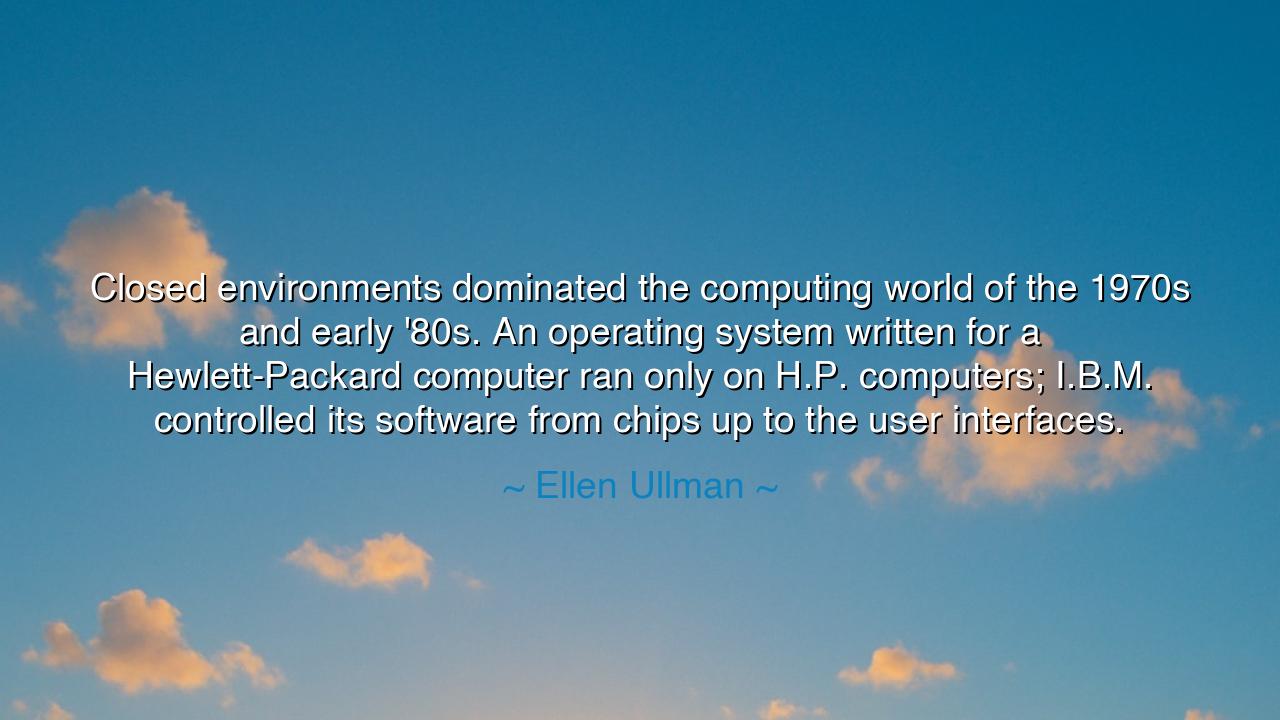
Closed environments dominated the computing world of the 1970s
Closed environments dominated the computing world of the 1970s and early '80s. An operating system written for a Hewlett-Packard computer ran only on H.P. computers; I.B.M. controlled its software from chips up to the user interfaces.






In the age before open horizons, when the dawn of the digital world was still dim and uncertain, closed environments ruled the land of machines. In those days, the computing world of the 1970s and early ’80s was a kingdom of walls — mighty yet confining. A man who built upon one mountain could not cross into another. A Hewlett-Packard machine knew only the tongue of its own maker, and an IBM device bowed only to its sovereign code. This was an age of control, of isolation, when each empire of silicon jealously guarded its dominion. Every operating system, every chip, every user interface was a fortress whose gates were sealed to outsiders. The world of technology was not yet a garden of shared light, but a maze of locked chambers.
Yet, from within those closed walls, a restlessness began to stir. For humanity, though it builds walls, is ever drawn to connection. The programmers and dreamers of that time — lonely artisans of the code — began to see that these barriers, though strong, also strangled creation. One could not learn freely; one could not share freely. The river of innovation was divided into rivulets, each flowing within the borders of a single house. Ellen Ullman, in her wisdom, looked back upon that era not with contempt, but with remembrance — for those walls were both the cradle and the cage of modern computing. From them, the desire for openness was born.
Hear now the tale of a young hacker in those days — Richard Stallman at the halls of MIT. He watched, with anguish, as once-open systems were locked by corporate keys. Once, when a printer malfunctioned, he sought to read its code to fix it, as all engineers had once done. But he was told: “You may not. It is proprietary.” And thus, a spark was kindled. From that denial rose the Free Software Movement, the cry that code should be shared, not chained. His rebellion echoed the yearning of all who lived in those closed worlds — the yearning to breathe in an open sky.
So too did others rise. Linus Torvalds, decades later, from his small desk in Finland, would forge Linux, an open realm where any soul might build upon the works of another. This was no mere act of rebellion — it was an act of restoration. For Ullman’s words speak not only of the past, but of the eternal cycle between control and freedom, between power and participation. The closed empires of the 1970s taught humankind a painful truth: that domination of systems, however efficient, breeds stagnation, while shared creation births vitality.
In Ullman’s reflection lies a deeper lesson — one beyond the realm of computers. Every age has its closed environments: its guarded institutions, its secretive hierarchies, its silenced voices. Whether in technology, in art, or in governance, those who hold power often seek to control the flow of knowledge. Yet the world advances only when doors are opened, when tools and wisdom are placed in the hands of many. Openness is not chaos — it is collaboration. It is the pulse of life itself.
Let us then remember this: the closed environments of the past are not merely historical — they reappear wherever fear of loss outweighs the courage to share. To be open is to risk imperfection, to welcome others into your creation. But it is also to kindle fires you could never light alone. Just as the open-source movement shattered the walls of the old computing world, so too can we, in our own crafts, strive for openness — in thought, in spirit, and in community.
The lesson is clear, children of the digital dawn: guard not your knowledge as treasure, but share it as light. Seek not dominion over systems, but harmony within them. Let your work be open to eyes yet unseen, for through such openness, the world renews itself. And in your daily life — whether you build, teach, or dream — ask yourself: “Am I building a wall, or a bridge?” Choose the bridge. For bridges endure, even when empires fall.
Thus, from Ullman’s memory of the closed environments of old, we learn the sacred rhythm of progress: creation, confinement, rebellion, and renewal. And as the ancients would say, “That which is open to all, serves all.”






AAdministratorAdministrator
Welcome, honored guests. Please leave a comment, we will respond soon